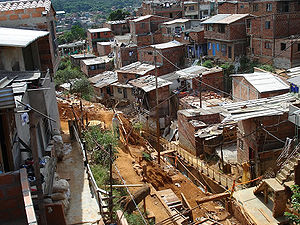Poverty in Colombia: Difference between revisions
Shirulashem (talk | contribs) m Reverted edits by 96.225.28.240 to last version by 190.24.155.218 (HG) |
|||
| Line 15: | Line 15: | ||
Colombia's [[Gini coefficient]] (a measurement of [[inequality]] in [[wealth distribution]]) was 0.51 in 2000 and 0.56 in 2006, making it the second-most unequal country in terms of wealth distribution, after [[Brazil]]. This means that 10 percent of the wealthiest homes have incomes 30 times higher than the 10 percent of poorest homes. In Colombia five financial groups control 92% of the assets. 36% are controlled by the [[Antioquia]]n Trade Group (Grupo Empresarial Antioqueño) and 28% are controlled by one person ([[Julio Mario Santo Domingo]]). An estimated 5% of the population owns and controls over 90% of the property in the country. Over 60.1% of Colombian homes are below the [[poverty threshold]].<ref> Tras el velo de la pobreza: La pobreza rural en Colombia, Alcides Gómez J |
Colombia's [[Gini coefficient]] (a measurement of [[inequality]] in [[wealth distribution]]) was 0.51 in 2000 and 0.56 in 2006, making it the second-most unequal country in terms of wealth distribution, after [[Brazil]]. This means that 10 percent of the wealthiest homes have incomes 30 times higher than the 10 percent of poorest homes. In Colombia five financial groups control 92% of the assets. 36% are controlled by the [[Antioquia]]n Trade Group (Grupo Empresarial Antioqueño) and 28% are controlled by one person ([[Julio Mario Santo Domingo]]). An estimated 5% of the population owns and controls over 90% of the property in the country. Over 60.1% of Colombian homes are below the [[poverty threshold]].<ref> Tras el velo de la pobreza: La pobreza rural en Colombia, Alcides Gómez J |
||
, Martha Alicia Duque G. ISBN 9586018059</ref> |
, Martha Alicia Duque G. ISBN 9586018059</ref> |
||
QUE UBO PARCE |
|||
===[[Economic recession]]=== |
===[[Economic recession]]=== |
||
Revision as of 03:26, 5 October 2008

Poverty in Colombia is a serious problem of misdistribution of income, characterized by some of the worst poverty statistics in Latin America. Both the Colombian government and the private organizations have been managing the poverty problem with a superficial approach, focused in charity-type programs, with poor outcome,[1] due primarily to the effects on the economy of social, political and economic events throughout the country's history and more recently the effect of the Colombian armed conflict.
Poverty statistics
The last CEPAL report includes data about extreme poverty in 45% of the general population and 17% homelessness, with an estimated 9,654,722 homeless people. (In comparison, the average figures in Latin America as a whole are 18% and 5%, respectively). [2]
Unemployment
Colombia has the highest rate of unemployment in Latin America, and a work market dominated by informal jobs, with no significant prospects for the creation of new work opportunities. The National Department of Statistics in its current report, points out that the unemployment index in the 7 main cities in the country is above 15.6%, meaning that about 3.7 million Colombians of working age don’t receive any income. About 32% of the people who do have work don’t have any formal work contract, nor access to the healthcare system. 48% of the Colombian work force derive their income from small scale informal economy such as street vendors and garbage recyclers. The unemployment situation in Colombia has been described by the CEPAL general secretary, José Antonio Ocampo, as “dramatic”.[3]
Inequality
Colombia's Gini coefficient (a measurement of inequality in wealth distribution) was 0.51 in 2000 and 0.56 in 2006, making it the second-most unequal country in terms of wealth distribution, after Brazil. This means that 10 percent of the wealthiest homes have incomes 30 times higher than the 10 percent of poorest homes. In Colombia five financial groups control 92% of the assets. 36% are controlled by the Antioquian Trade Group (Grupo Empresarial Antioqueño) and 28% are controlled by one person (Julio Mario Santo Domingo). An estimated 5% of the population owns and controls over 90% of the property in the country. Over 60.1% of Colombian homes are below the poverty threshold.[4]
Economic recession
Since the late 1990s, many important economic sectors in Colombia have experienced recession, worsening the poverty situation in the country. The most affected sectors are the agricultural, manufacturing, transportation and building industries, which are the main sources of employment in the country. The global growth of these economic sectors, compared with the population growth in the same period gives an index of 0.7, indicating a larger growth in the number of people needing jobs than the number of employment positions on offer.[5]
Related Issues
Illiteracy
The current index of illiteracy in the country is 7.6%, with areas such as Chocó Department and Sucre Department having a 16% level. These rates shows a worsening of the illiteracy index, compared with those 20 years ago, when in the same areas the rate was 13.5%. Probable causes are the Colombian armed conflict and the insufficiency of funds destined for education in Colombia.
Malnutrition
Over 500 000 children under 5 years old (13%) in Colombia suffer from acute malnutrition and up to 30% suffer from chronic malnutrition, the most affected areas being Boyacá and Nariño Department.[6]
References
- ^ Observatorio de la Economía Latinoamericana. http://www.eumed.net/cursecon/ecolat/
- ^ Fuente: Sarmiento Anzola, Libardo. Exclusión, Exclusión y Desarrollo Societal. Nov. Ed. Desde Abajo. Datos de Desplazamiento Forzado: Codees Informa No. 26. p.3
- ^ AP agency, February 21st 2007, Miami New Herald
- ^ Tras el velo de la pobreza: La pobreza rural en Colombia, Alcides Gómez J , Martha Alicia Duque G. ISBN 9586018059
- ^ Colombia Actividad Económica, 1995 2001 Note: Variación anual del producto interno bruto trimestral (PIB). Source: Departamento Administrativo Nacional de Estadística y Departamento Nacional de Planeación
- ^ Desnutrición en Colombia
hola la pobreza es muy mala
